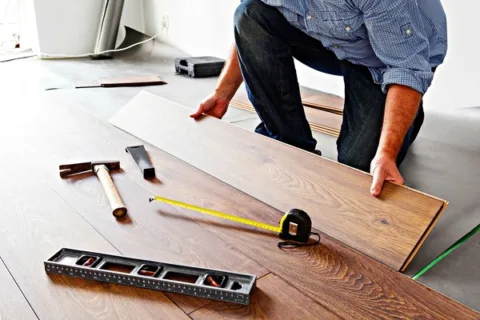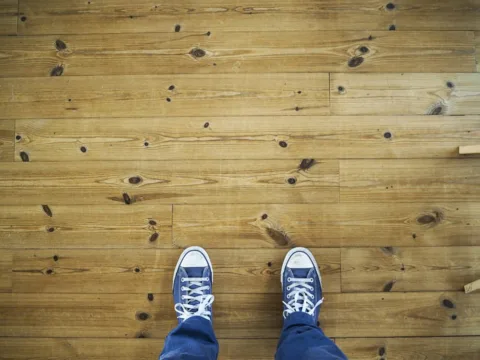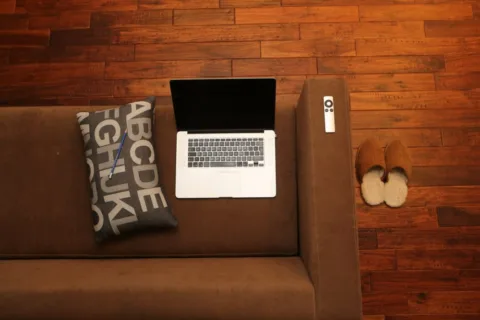The struggle is real, folks — laminate wood flooring or hardwood?
When building or remodeling your home, there comes a point when it’s time to decide what to do about the floors.
If you want to keep a natural look that also adds class, it’s hard to go wrong with wood.
But then you also have choices between solid, natural hardwood flooring and laminate wood flooring that looks like hardwood. Both are beautiful — so which is the better choice?
Must read: What’s The Difference Between Engineered & Laminate Floors?
Growing up we had hardwood floors and it was really difficult to keep them pristine like my parents wanted. Water damage, scratches, and fading from the sun used to drive my parents crazy — like “code blue emergency” crazy! I’ll never forget the time a condensation ring was found around my glass of milk on the floor.
When it was my turn to build a house, we went with laminate wood flooring. It was great for us with toddlers and pets. Let’s just say I was much calmer than my parents were when my kids spilled or played with their toys on the laminate.
Nevertheless, you’ll have to choose what’s best for you.
Here are the criteria I used to decide and pros and cons of both laminate wood flooring and real hardwood floors.
Making The Choice
Both laminate wood flooring and hardwood flooring can be beautiful options for your home. The best choice really comes down to your budget, desired features, and personal preference.
Here are the 3 factors I used when deciding between laminate wood floors vs hardwood:
#1 – Budget. Based on the square footage of the house, laminate wood flooring was cheaper.
#2 – Durability and lifestyle. Since we had 1 golden retriever and 2 kids, laminate worked for us. That way, I wasn’t frantic any time there was an accident in the home. (No “code blues” for me!)
#3 – Resale value. We researched our area and the design of the home and found that hardwood floors would not increase the value of the home.
You should do the same thing — weigh the pros and cons of both to determine which is best for you.
Let’s look at pros and cons of laminate wood flooring first.
All About Laminate Wood Flooring
Laminate wood flooring might look like wood, but it’s really a composite of wood that has been pressed and subjected to high temperatures.
On top of this pressed composite is a thin layer with a specific design or image on top.
If you’re looking for laminate flooring that looks like wood, then this top layer will look like your choice of wood.
Here are some of the benefits of installing laminate wood flooring:
- Less expensive. There are varying levels of cost – the cheaper laminate looks a little less like wood and more like cheaper flooring.
- Looks like real wood. Higher quality laminate flooring looks more like real wood and probably costs a bit more than its imitation relatives.
- Lower installation cost. The nice thing is that you can save on installation and labor by installing laminate yourself.
- More durable over time. It’s made to withstand some abuse and can typically hold up well against movement.
- Easier to care for. Laminate flooring is so simple to care for. It’s a good idea to sweep and vacuum it regularly. Use a non-detergent laminate floor cleaner
to provide a deeper clean and remove caked on messes.
TIP: You’ll want to put protective pads on the ends of furniture legs and avoid walking on the flooring with high heels.
Here are some tips for replacing laminate wood flooring.
These are some of the drawbacks to installing laminate wood flooring:
- Sound. When you walk on a laminate floor, it produces a hollow sound that makes the material feel fake and manufactured.
- Unnatural feel. While laminate can simulate the look of hardwood, stone, or brick perfectly, the illusion fades as soon as you feel the material with your bare hands.
- Hard. Laminate flooring is quite hard and unyielding under foot. Even using cork or foam padding on the back will generally not fix it.
- Lifespan. Most laminate floors come with a warranty. However, it’s important to check the terms and conditions of that warranty before you buy.
TIP: You can alleviate the hollow sound by using underlayment materials — which simulates the sound of natural hardwood flooring.
There were once concerns about the materials used when manufacturing laminate wood flooring. You can rest assured the EPA has looked into it.
There’s no cause for concern. The amount of formaldehyde in the laminate flooring, if present, can vary due to how the flooring is made. Formaldehyde is normally present at low levels, usually less than 0.03 parts per million (ppm), in both outdoor and indoor air. Source
All About Hardwood Flooring
Hardwood floors are made from real, natural wood that comes from trees all over the world.
Hardwood floors not only add a rich variety of color and texture to a space, they also provide many perks that can enhance your living space.
Here are some benefits to having real hardwood floors:
- Lots of options. There are many popular types of hardwood for floors — including maple, rosewood, oak, cherry, pine, hickory, ash, walnut, and jatoba.
- The aesthetic appeal. Hardwoods tend to look gorgeous and have an appearance that is difficult to imitate even with the best laminate.
- Inexpensive repairs. Typically repairing a solid hardwood floor involves just a bit of sanding and refinishing.
- Ease of maintenance. Hardwood flooring isn’t overly difficult to care for. You simply need to sweep and vacuum regularly — and invest in a floor cleaner that is safe for hardwoods
. With proper maintenance and care, hardwood floors will last for centuries.
- Great insulation. A wood floor is a wonderful insulator that retains heat — which makes it comfortable to walk on and gives a cozy feeling to the space.
Here are some questions to ask before choosing hardwood flooring.
These are some of the disadvantages of real hardwood floors:
- Moisture damage. Even a small amount of moisture can deteriorate the wood — so be careful to mop up spills fast (and if you have a leak, get it fixed).
- Somewhat difficult to install. You’ll want to hire a professional and have them check your floor substructure first. If it’s uneven or unstable, it will make the installation problematic and later cause it to bend and open.
- Scratches easily. Some shoes and your pet’s sharp claws can leave dents and scratches on hardwood flooring. The durability of your wood floors depends on the type of hardwood you choose.
- Noise. When you walk on it (especially with hard leather boots and shoes), the footsteps can seem loud. Some people find wood-floor noise a nuisance but you can soundproof hardwood.
- Price. A real hardwood floor can be expensive. Plan to spend anywhere between $5 – $10 per square foot.
- You may need to cover it to protect it. It’s a good idea to protect high-traffic hardwood surfaces with rugs
and furniture pads
.
After several years of normal wear and tear on your hardwood flooring, you’ll eventually need to refinish it at some point. Doing so makes it look like new again.
You can only sand some engineered floors once or twice, and although solid boards can sustain more refinishes, the number isn’t unlimited. Source
More Tips For Choosing Your Flooring
In addition to the links I’ve included above, here are some other thoughts on wood laminate vs. hardwood flooring:







